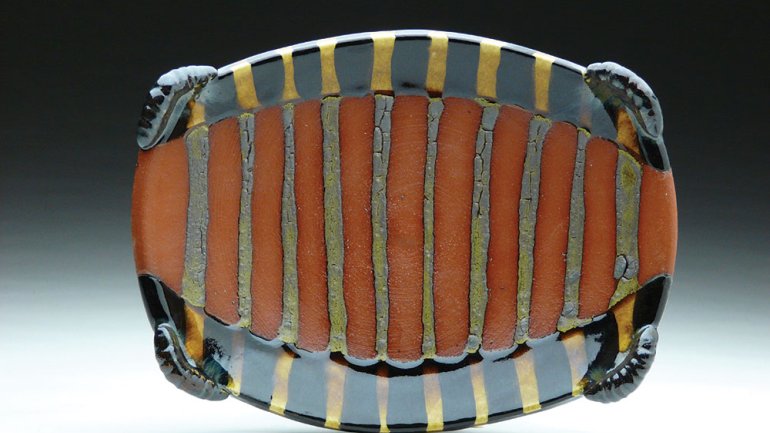Down to Earth
Down to Earth
Stones. piles of leaves. Fallen branches covered with lichen. Those were Ronan Peterson’s toys, plentiful in the woods surrounding his family’s home high in the North Carolina mountains.
“I was outside all the time,” says Peterson, who still lives in a wooded area, now in Chapel Hill with his wife and two sons. “In the mountains in the summer, everything is green and full and fluffy, but in the winter it’s skeletal and unforgiving.”
On the dense surface of his intensively decorative pottery, Peterson aims to embrace growth and decay through layering patterns, colors, and textures on red earthenware clay. An exuberant burst of green might be offset by a swath of dark circles; a sea of dancing dots is partly obscured by a patch of crawling glaze, its crackles resembling the lichen of his youth.
Peterson, whose name is pronounced “RON-an,” learned about his state’s pottery traditions as an anthropology and folklore student at the University of North Carolina. (He was the first in his family to attend college.) His interest in mountain lore took him to the John C. Campbell Folk School, where he took his first clay class in 1997. He rounded out his training in the two-year Core Fellowship Program at Penland School of Crafts, where he also met his wife, artist Kara Ikenberry.
“From the beginning, I immediately was drawn to colors and building up layers,” says Peterson. He credits his attraction to bright hues and fat edges to his father’s vast comics collection. “Comic books are saturated with color and thick lines, like drawing with Sharpies.”
Since moving to Chapel Hill in 2003, Peterson, 39, has worked out of a small studio originally built for his mother-in-law, professional potter Carolyn Ikenberry, who is now retired. “Her husband made this wheel in 1971 as a wedding gift,” he says, demonstrating the simple setup. “The same cotton string still engages the motor, which is from a washing machine. I still have this mentality from my dad and my grandparents about using things until they’re done. It fits into the only business plan I’ve had: Keep overhead as low as possible.”
Peterson named his studio Nine Toes Pottery, a reminder of the lawn mower accident he had at age 18 that sheared off the top half of his right middle toe. (Although you wouldn’t figure it out on your own, the stamp Peterson uses to mark his work is a little homage to the missing digit.)
He throws most of his work, and sometimes handbuilds in the final stages. Most of his pieces are on the small side – mugs, vases, and bowls – along with a line of larger platters that stretch the limits of his tight space. He holds occasional studio sales and is invited to a host of gallery shows throughout the year, some accompanied by teaching workshops. Regardless of the venue, he stays busy keeping up inventory, which sells fast.
While some artists edge toward larger, sculptural work, Peterson’s goal is deeper colors. A few years ago he added a blue to his mostly green and red palette. “Blue is the pottery snob’s bane because it’s so common and easy to sell, but my blue isn’t a comfortable blue. It’s got a little brightness. Plus it’s kind of fun to go against the mainstream,” he says slyly. “Now I have this orange I’m interested in, and a purple and blue glaze that I’m trying to get right.”
Lately, Peterson has been taking cues from painters, especially on his platters, where there’s more space to play.
“I’ve been looking at Klee and Miró and others, and find myself inspired by the compositions. In my more shape-oriented pieces, like mugs, the form motivates the decoration. But with the platters, it’s more my imagination. I’m telling it what to do. So I’m really interested in seeing where that goes.”
Diane Daniel is a writer in Durham, North Carolina.

